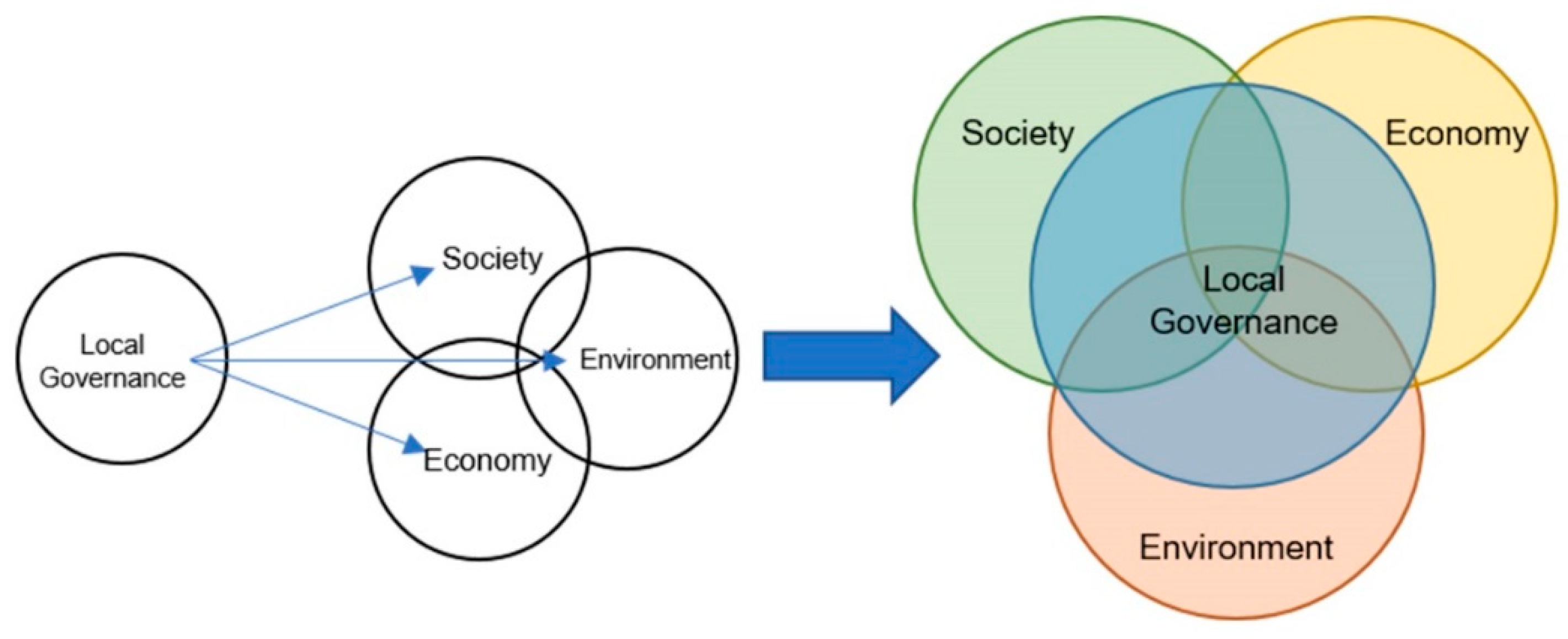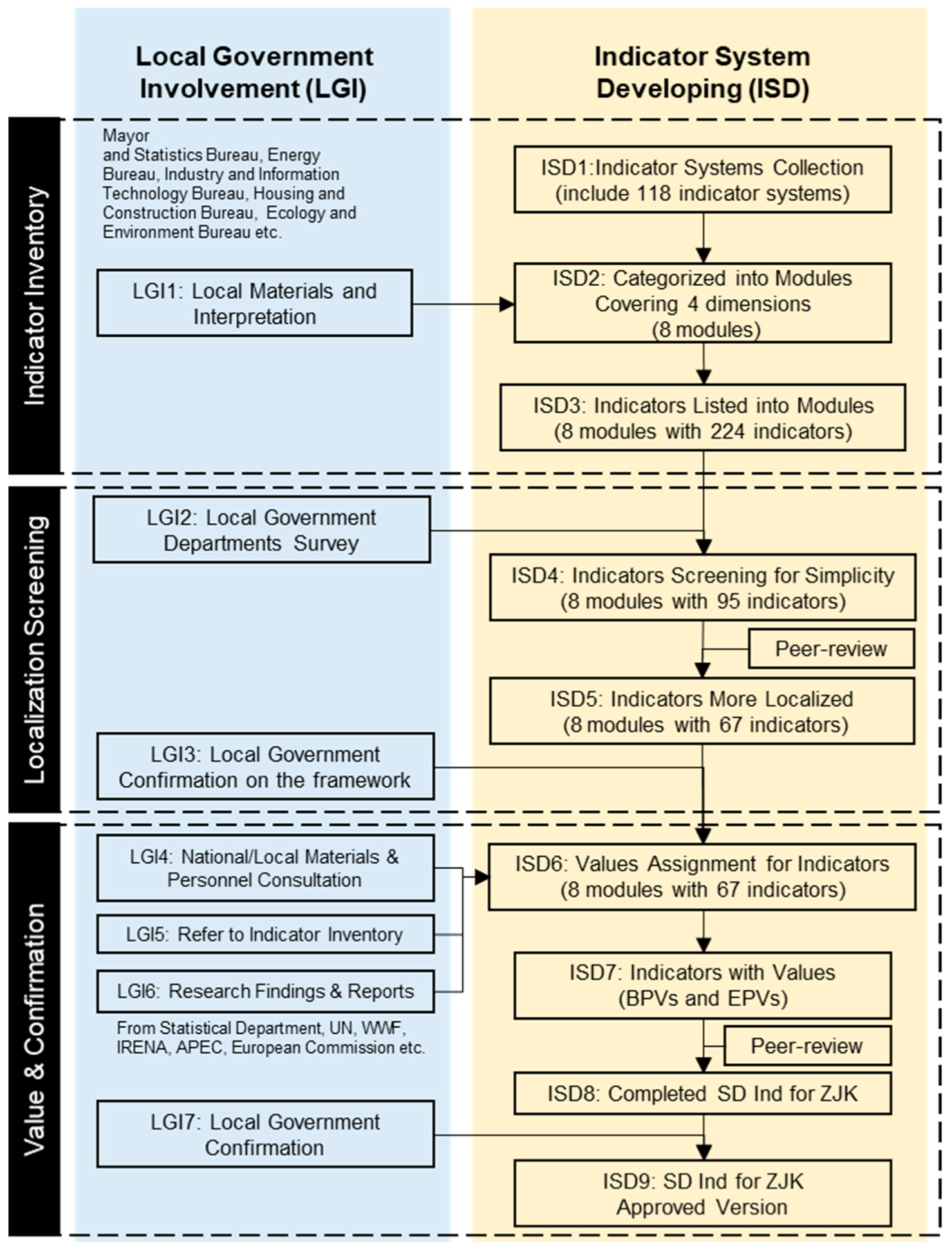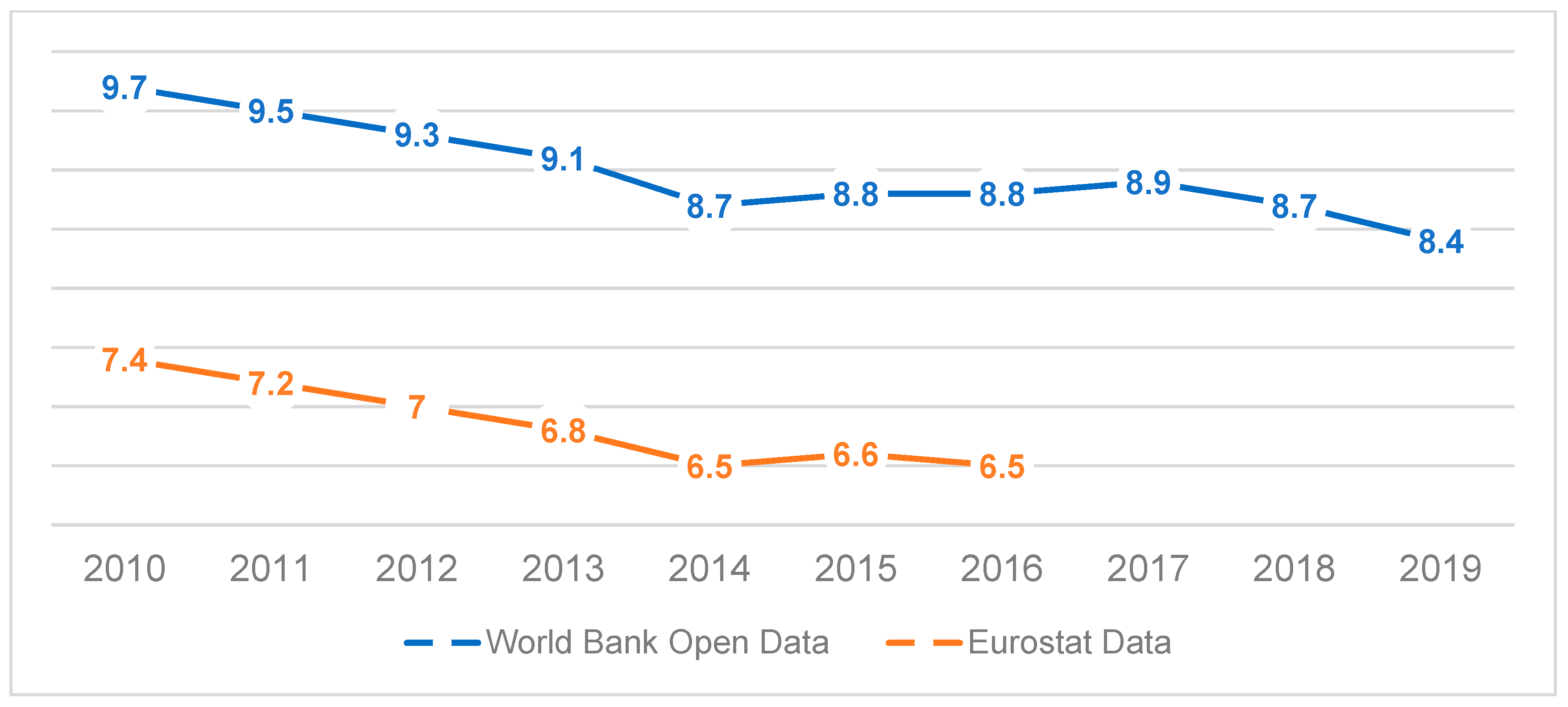1. Introduction
Tackling climate change has become a topic of widespread concern in the international community. At present, a meaningful way to combat climate change is carbon reduction and has been widely concerned and recognized. In realizing a carbon reduction plan, cities play a critical role. Cities are responsible for about 70% of global carbon emissions [
1] and consume two-thirds of the world’s energy [
2]. There is an agreement of academic and policy that cities, or other types of urban settlements, are the nexus of sustainable city development and carbon emission reduction [
3]. Moreover, cities are beset by socio-economic issues [
4]. Therefore, integrating sustainable city development with energy transition is feasible and essential to achieving carbon reduction goals. As sustainable development guidelines, it is more practical to establish city sustainability evaluation systems to guide this transformation (which integrate energy issues and city development).
The concept of sustainable city development is still relatively open, various [
5,
6], and still changing and evolving [
7]. The original sustainable city development concept emphasized intergenerational equity [
8]. Nevertheless, in the case of a specific region, some localized goals and demands significant influence. For example, in the APEC region, optimization of production and output, minimization of pollution and efficient land use, and coordinated development between urban and rural areas are specific objectives [
8,
9]. This openness creates more opportunities for different stakeholders to participate and express their demands [
10]. Furthermore, this also allows various evaluation approaches to try to drive and witness this process.
Among these approaches, the three-pillar approach was identified as one of the most explicit sustainability evaluation models in Integrated Environmental and Economic Accounting 2003 [
11]. Furthermore, based on this approach, the three-pillar evaluation model has been widely recognized and applied [
12]. In further studies, researchers tried to add more evaluation dimensions beyond environment, society, and economy, constituting the developments of this basic evaluation model. Reyes Nieto, Rigueiro, Simões da Silva and Murtinho [
13] developed the UISA fEn (Urban Integrated Sustainable Assessment Methodology for Existing Neighborhoods) tool to analyze existing evaluation systems by adding the management dimension, and demonstrated management’s vital function in coordinating the relationship between environment, society, and economy. Alternatively, using the cultural dimension emphasized the trend of social diversification and the protection and utilization of local culture [
14]. As the first global city sustainability evaluation system, macro-management, infrastructure, and other dimensions were added to ISO37120: 2018 to establish a more comprehensive sustainable city development evaluation system [
15]. However, cities are complex [
16]. Sustainable city development involves many aspects, making them have complexity and fuzzification [
17]. The interaction of all aspects would affect sustainable development’s practical efficiency and results [
18]. Therefore, it is still meaningful to explore the development of the evaluation model and put it into practice, which fully considers cities’ actual situation. Further research makes city governance’s role in sustainable development recognized. When Salmoral, Zegarra, Vázquez-Rowe, González, del Castillo, Saravia, Graves, Rey and Knox [
19] analyzed the development problems of Arequipa, Peru, they found that the lack of local governance exposed the city to a severe vulnerability in terms of land and water resources and affected the overall development of the city. According to the research of The European Charter for the Safeguarding of Human Rights in the City, Marsal-Llacuna [
20] believed that good local governance played an important role in realizing sustainable city development and coordinating various interest groups.
Since 2010, more than 70 cities have participated in the Low-Carbon Pilot City project. Furthermore, explore pathways to adapt to the sustainable development of different cities. In this process, the pilot city governments began to change cities’ energy mix, promote green buildings and electric cars, and promote infrastructure [
21,
22,
23]. The series of actions formed part of the basis for achieving the goal of supporting China’s carbon neutrality in the future. However, low carbon is not the ultimate goal of sustainable city development. Good city governance can be crucial for China’s cities to achieve sustainable development for more complex problems. In their study of Guiyang, Chung and Xu [
24] acknowledged that city governance plays an essential role in balancing the pressure of economic growth and environmental protection for Chinese cities. Deng, Cheshmehzangi, Ma and Peng [
25] demonstrated that good city governance could effectively mobilize various stakeholders involved in city development and economic and social resources to participate in sustainable development by studying the latest practices of sustainable city development in China. So, the question concerning how to effectively mobilize the participation of local government and guide and monitor the city’s sustainable development became very important. Rather than simply developing a third-party evaluation tool. Through SD Ind for ZJK, an open and transparent way was explored between local government and experts to express their development demands and opinions in the development process. The goals and paths of sustainable city development can become more explicit, and this is significant to guide and monitor sustainable development.
The three-pillar evaluation model was established based on the three-pillar approach and its development types lay a foundation for the evaluation system of sustainable city development and support the formation of the multi-module evaluation system. These models tend to include several modules (such as building, transportation, water management, energy consumption, air quality, and waste management) [
14], and serve one or more of the environmental, social, and economic dimensions. These modules reflect the complex interaction between the various components of the city. The integration of these modules represents the basis for evaluating the sustainability of city development [
26,
27]. Carbon neutrality leads energy modules to receive more attention due to energy and carbon emissions as a field that attracts widespread concerns globally. Researchers pointed out that energy policy was inextricably linked to sustainable city development and was crucial to achieving development goals [
28,
29]. Additionally, renewable energy has a significant impact [
30,
31,
32,
33]. Senpong and Wiwattanadate [
34] explored solar, wind and small-scale hydropower in Krabi Province, Thailand, to improve the status of local sustainability. The data showed that these would bring considerable benefits to the local economy, environmental protection, and energy security. In the Caribbean Islands of Antigua and Barbuda, Karaca, Dincer and Nitefor [
35], through simulation, found that rational use of wind and solar energy could effectively solve and improve the region’s energy resilience. Rational energy use is one of the best practices to achieve sustainable city development and carbon neutrality [
28,
36]. A series of work represented by APEC LCMT (APEC Low-Carbon Model Town) Project has carried out research and practice on city low-carbon sustainable development through energy transformation from energy production, transmission, utilization and storage [
37]. Zhen, Huang, Li, Wu and Wang [
38] and Zhai, Ma, Gao, Zhang, Hong, Zhang, Yuan and Li [
39] analyzed two Chinese cities, Jinan and Tangshan. Through statistical data and simulation analysis, they concluded that renewable energy has positive significance for promoting Chinese cities’ sustainable development. The contributions of the energy transition to urban and rural sustainable development were also made evident [
40].
There are still some problems in the development process of the sustainable city development evaluation systems. The developers include different governments, NGOs, industries, and academia, but a transparent and widely consulted development process was not valued [
41]. Angelakoglou, Kourtzanidis, Giourka, Apostolopoulos, Nikolopoulos and Kantorovitch [
42] attempted to use a comprehensive pool of KPI to build a project-specific indicator list for smart cities energy transition. However, still plagued by subjective factors from experts. Another 41 studies criticized the lack of transparency and stakeholder involvement in developing such evaluation systems [
43]. In most cases, the selection of indicators was vague or lack of communication with local government [
44,
45]. Cities’ demands and strategies were difficult to take seriously [
46]. Although relevant experts’ supports are needed, the neglect of cities’ demands and realities leads to inappropriate evaluation systems. Alternatively, evaluation systems are market-oriented and do not respond to local needs and priorities [
47]. Another issue is weighting. The addition of weight is an effective way to balance various factors. Nevertheless, weights will make people pay more attention to indicators with higher weights [
48]. The cases of LEED-ND (LEED for neighborhood development) showed that indicators that require substantial financial supports (such as affordable housing, energy efficiency, and water efficiency) were often overlooked [
49]. On the other hand, weighting is also the most controversial part, since it is challenging to compare and rank different indicators [
50]. The influence of experts’ opinions on weighting is often decisive and makes it a challenge to consider the views of city managers or other stakeholder requirements [
51], which often leads to severe disagreements [
52]. Sharifi and Murayama [
45] compared seven evaluation tools for sustainable city development. They pointed out that the evaluation systems with weights often aimed to obtain aggregate sustainable development indexes or had similar goals. However, the evaluation systems such as HQE
2R and Ecocity mainly showed the performance of each module, so there was no direct weighting for indicators, thus reducing the influence of subjective factors [
45]. In addition, SDG Indicators and ISO37120: 2008, as guiding evaluation systems for global sustainable development, did not have weighting but tended to monitor development performance.
Sustainable Development Indicators for Zhangjiakou (SD Ind for ZJK) attempted to guide and monitor how to realize sustainable city development in the critical period of Zhangjiakou city, especially in the 14th FYP period. Zhangjiakou needs to consider coordinating the construction of the Water-conservation and Ecological-environmental Support Area of Capital (Two Areas) and the National Renewable Energy Demonstration Zone in the post-Winter Olympics era. Other considerable development tasks are consolidating its anti-poverty achievements and enhancing its international influence. We accepted the authorization of the Zhangjiakou Municipal Government. Through in-depth communication with city management departments and experts, we accurately understood Zhangjiakou’s development tasks in the future. Moreover, we reviewed 118 city sustainability evaluation systems, and based on our understanding of these tasks, formed the indicator inventory and our indicators system.
The paper was organized into four sections. The
Section 1 introduced the evaluation model of SD Ind for ZJK and the working flow. In the
Section 2, based on the local demands of Zhangjiakou, the indicator framework was established. Moreover, the indicator system development process was described. The
Section 3 gives the indicators in each module and their value. In the
Section 4, discrepancy and resolution were explained, and limitations were discussed. Since cities have common or similar sustainable development goals, this paper can provide a reference.
5. Discussion
As an indicator system for sustainable city development, the carbon emission indicator is one of the core issues. In the process of formulating the indicator system, experts had more discussions on this point. In the end, however, there were disagreements among the experts. The authors chose per capita carbon dioxide emission, one of the global measures of carbon emissions [
88]. According to the WWF research report on Zhangjiakou [
59], per capita carbon dioxide emission in Zhangjiakou city should be between 9.4 and 6.5 tons by 2025. Moreover, one should determine the initial BPV and EPV, i.e., 9.4 tons/person and 6.5 tons/person. During expert consultation and charrette, the selection of BPV was considered reasonable. Nevertheless, some experts thought EPV was too radical for Zhangjiakou’s city development level. The EPV should be raised to around eight tones, but some experts opposed it.
Such disagreement puts the authors in a relatively awkward position. Since the per capita carbon dioxide emission was the key indicator, it needed a reasonable EPV. The authors did a comparative study. According to research by Dadi Zhou [
89] and Yongda He [
90], per capita emissions of Hebei province should be below 9 tons by 2025, or close to current European Union levels. Public data from the World Bank [
91] and Eurostat [
92] showed that the current value should be below 8.4 tons (shown in
Figure 3). Other researchers believed that China’s per capita carbon dioxide emission in 2025 would be between 7.3 to 8.3 tons [
93,
94].
Based on the research findings of international and domestic researchers and institutions, we decided that by 2025, the EPV of per capita CO2 emission would be 8.3 tons. The local government approved the result. However, it should be noted that as part of a future-oriented city indicators system, the performance values may need to be updated when more reliable research achievement is available.
Zhangjiakou is an inland city in China. As a result, in SD Ind for ZJK, the indicators only applicable to waterfront cities were not selected. This point should be considered when waterfront cities formulate city sustainability evaluation systems. In addition, as the only nation-level Renewable Energy Demonstration Zone in China, Zhangjiakou’s performance in city renewable energy production and utilization is better than in other cities. Even related industries are better than other cities. Other cities should consider Zhangjiakou’s unique policy environment when selecting indicators to guide and promote renewable energy development. This point also inspires the formulation of appropriate implementation plans based on the indicator system (i.e., policy tools, evaluation indicators, and implementation plans should be consistent).
Through SD Ind for ZJK project, the authors believe that Zhangjiakou has its particularity, but it should not be alone. How to identify and classify similar cities based on indicators of the natural environment and socio-economic development should be part of future work. The classification will make city managers more confident about introducing certain policy tools and development experience. On the other hand, the effective identification of city types will provide some basis for other research and work, such as using relatively objective methods to determine the weight of indicators or establishing a targeted city sustainability database to support more research in the future. On this basis, how to use the research results and findings of sustainable city development will become more evident.
6. Conclusions
Sustainable city development is the result of the positive interaction of many aspects. Energy transition, governance, innovation, coordinated development, environment, and inclusion are all integral parts of a sustainable city (even the most essential parts of some cities). This variety of aspects circulates around the cities’ demands, which causally related to citizens’ needs. Therefore, the success of a sustainable evaluation system needs to be achieved through a specific and customized indicator system. Indicators need to be defined according to the scope of the specific city developing strategies and demands.
One of the core goals of this paper is to provide a method of establishing an indicator system using a scientific procedure that integrates the cities’ demands, local governance, and the evaluation system on sustainable city development to promote applicability. SD Ind for ZJK was developed with international and localized perspectives. The evaluation model integrating local governance based on the three-pillar evaluation model and the interactive decision-making process can form an interactive decision-making mechanism to promote the participation of stakeholders in sustainable city development. As a result, the eight-module indicator framework explored and practiced the method and formed the foundation for subsequent work. On the other hand, in addition to the transparent and inclusive establishment process of the framework, exploring a reasonable indicator localization screening procedure is another core goal that can provide reference and guide to developing sustainable city evaluation systems integrated with city-special demands. The extensive indicator inventory formed after a review of 118 relevant sustainable city evaluation systems and a final indicator list selected based on a reasonable procedure for increasing adaptability of results can provide a reference for the development process of a similar system. Compared to the indicator inventory with 224 indicators, the result of 67 indicators provides a decent balance between monitoring feasibility and convenience and quantity of the critical relevant indicators. Thus, the method helped us get a succinct and comprehensive indicator system for monitoring the impact of sustainable city development policies and improving understanding of city dynamics. Thirdly, exploring a way to consider future development goals and remind of policy or technical obstacles. BPVs and EPVs were given to indicators. Compared with BPVs, EPVs targets consider different scenarios that may occur in the future, such as achieving carbon neutrality, overfulfilling development plans, or more optimistic development outcomes. Setting EPVs can, on the one hand, monitor the status of the impact of sustainable city development. On the other hand, in determining that BPVs and EPVs indicators cannot be set directly, communication with local governments and experts can more accurately identify weaknesses or development bottlenecks in sustainable development, showing the significance and necessity of the interactive decision-making process.
We strive as objectively as possible in the whole process. The results were peer-reviewed and agreed by the local government, nevertheless, there is still a degree of subjectivity involved. Due to the divergent management of indicator scoring and assignment process, subjective factors were inevitably introduced but aimed to respond to Zhangjiakou’s needs. Zhangjiakou is an inland city with a special policy environment. These factors influence the selection of indicators. Geographical factors and policy environment should be considered when ZJK’s SD Ind is used as a reference for developing other indicator systems. This paper does not discuss how to identify cities similar to Zhangjiakou, which should be part of the consequent work. The identification and classification will give city managers more confidence to introduce evaluation indicators, policy tools and development experience. Moreover, provide a certain basis for other research and work.










